Collecting AIDS stamps
Collecting stamps about AIDS awareness can be a fun and rewarding hobby. You can spend as much or as little money and time on your collection as you would like. And whether you plan to post it on the web, enter competitions, or just show it off to the occasional friend, you will learn much about stamps, geography, and the world we live in.
Of course your collection doesn't have to be designed with the same focus as mine. Many people enjoy collecting first day covers while I find them to be a waste of perfectly good stamps. Others enjoy collecting pre-printed postcards and envelopes with AIDS awareness messages on them. Still others enjoy collecting postal cancellation marks about AIDS.
"Traditional" AIDS stamps
Most AIDS stamps on the market are released by postal agencies to promote awareness and education about AIDS or express compassion for people who are living or have died from AIDS. There are a vast array of designs available. Some collectors collect everything that they can get their hands on, while others collect designs or sub-issues that appeal to them.


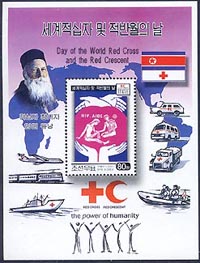
People with AIDS
I personally have no interest in collecting stamps about people with AIDS, but they remain a powerful draw for some. Consider these stamps:




These are just a few stamps of people with AIDS, both living and deceased. Oh, and in case you were wondering, they are Freddie Mercury, Rock Hudson, Liberace, and Greg Louganis. There are plenty of other PWA's on stamps for the so-inclined to collect. Check out our PWA stamps page to learn more.
Personalized stamps
Whether to collect personalized stamps is decision you will need to make. Personalized stamps are issued by the post office or authorized representatives but contain images that were selected by the customer rather than the postal service. Sometimes the stamps are used to raise money for charity, other times they are for personal use. In theory there only limit to the possible number of personalized stamps depends entirely on customer imagination and demand.
The lure of the personalized stamp cannot be denied. The Global Fund and Confessionsofapoet's page on Zazzle are both good places to start learning about them.
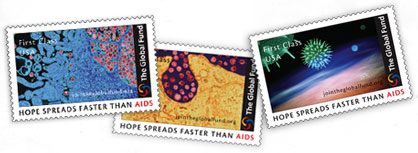
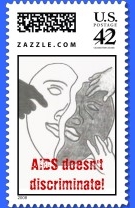
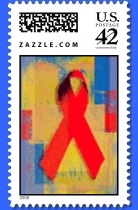
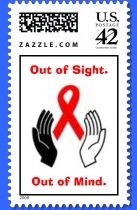
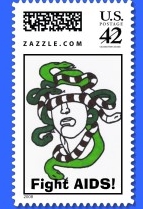
Personalized stamps can be released in countries outside the United States as well. I recall a personalized Austrian stamp based on the Life Ball AIDS benefit in 2005. It featured the head of Austria's postal union with Heidi Klum, star of that year's Life Ball stamp.
New collectors should be aware that personalized stamps will not be found in the Scott Guide as they are not officially released by any issuing authority.
Not AIDS-related
Collectors of AIDS stamps should be aware of potential confusion when doing their research. Many sellers mistakenly advertise their stamps as AIDS-related when they are not. For example, consider these two stamps.
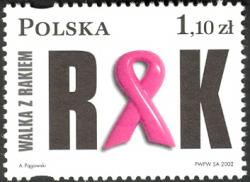
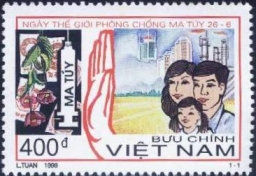
The first features the pink ribbon of breast cancer awareness. This is often confused with the red ribbon for AIDS. The Polish word for "rak" also means "cancer". In the case of the Viet Nam stamp, this is an anti-drug use stamp. While there is a connection between AIDS and intravenous drug use, this stamp was not intended to reflect the issue of AIDS. There are plenty of others you will find as you embark on your collection. When in doubt, drop me an e-mail and I'll give you my two cents.
AIDS on stamps features a not about AIDS page to make your research easier more convienent.
Cinderella stamps
Cinderella stamps are those that are released by private organizations or individuals with the intention of expressing a message instead of being used as valid postage. Sometimes they are distributed for free, other times they are sold (usually to raise money for charity or to cover printing costs).
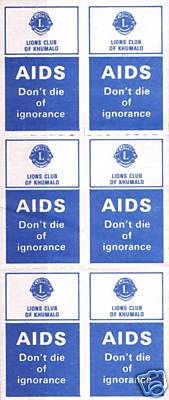
Local posts and artstamps
Historically, local posts were limited postal services operating within a region, city, or even a single transportation route, sometimes privately and sometimes by a government. Today, many hobbyists have taken advantage of postal laws covering local posts to create their own local post. These hobbyist local posts typically do not carry any mail, but do allow them to attach their own stamps and cancellation marks to the lower-left corner of envelopes. More information is available on the Local Post Collectors Society website.
A number of local post hobbyists have released AIDS stamps for their "service". Because these stamps have no value per se (ie; not valid for postage anywhere except in their hobby postal service), it can be difficult to obtain their stamps. Philatelists who want to add these stamps to their collection may want to contact the "local post postmaster" directly.
Artstamps are a variation on this practice. Rather than create them as a hobby, artstamps are created for the artistic aspect. These can range from simple electronic designs to expensive pieces of artwork reproduced in stamp form.

Non-existant stamps
Then there's the issue of nonexistent stamps. A website with an incorrect Scott number can send you surfing the web for hours at a time. For me, the bane of my existence has been an Iranian stamp featuring a red ribbon similar to the 2003 USA and China stamps. An international AIDS organization reported that the Iranian postal service was releasing an AIDS stamp for World AIDS Day in 2005. Bloggers picked up on it and world media followed soon after.
As near as I can tell, this stamp was never released. It has not been carried by any of the major dealers in contemporary stamps from Iran. It was not submitted by Iran to the Universal Postal Union's WADP numbering program. It is not featured on the Iranian postal website, and there is no picture of it anywhere on the web.
Illegal and counterfeit stamps
Even when a stamp exists it has not necessarily been legitimately produced. There are two primary types of illegal stamps: those that impersonate a valid government, and those that claim to represent a nonexistant one. Although the bulk of this industry is marketed toward highly-sought after topicals (animals, celebrities, etc.), AIDS stamps are not immune.
Here are two examples:

I had heard rumors that the Niger stamp was invalid and was suspicious because of the high number of websites that were selling this crudely-designed stamp. It seemed a bit too available for an 11 year-old stamp. Sure enough, today I found this letter from the Nigerian government to the Universal Postal Union. Verdict? An illegally produced stamp.
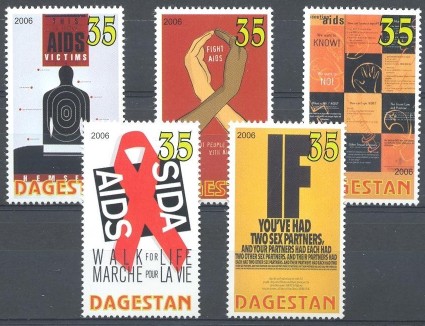
In this case of the Dagestan stamps, I was suspicious about this because there is no real government named Dagestan, and because all of the writing is in English. Dagestan is, for those not in the know, a province in Russia. It would be like buying a postage stamp from the government of Idaho with the writing in French. Like the last example, there is an interesting letter about this case. A publication from the UPU provides more evidence (do a search for the word "Dagestan").
The issue of what is legal often depends on the judgment of history. The island of Cyprus is split into two countries: Cyprus, recognized by 99% of the world as consisting of the entire island, and Turkish Cyprus, recognized only by Turkey. Turkish Cyprus has issued two stamps about AIDS. Are they illegal releases? Cyprus says so in this UPU circular. Turkey would beg to differ. How the stamps are finally classified will depend on how the political situation is ultimately resolved, although stamp collectors will probably collect the stamps anyway as having an interesting and unique background.


For more information on illegal stamps, check out the Philatelic Webmasters Organization's illegal stamp site. You can also check out this website's counterfeit stamp page.
Excessive stamps
Sadly, even when a stamp is legal and valid it doesn't mean that the stamp was well-intended. There is the issue of excessive stamps to consider. If you're the head of oh, say, Berzerkistan, and you'd like to make a bit of extra money for your government, you can contract with certain shady companies to develop and produce topical stamps that appeal to collectors. Your postal service will official recognize them as valid postage thereby making them legitimate. But instead of marketing them yourself, the companies will mostoly or completely market the stamps to collectors outside of your country. So instead of issuing, say, 30 stamps per year, you can issue 600 stamps instead and bring in some bucks. These are called "excessive stamps".
Fortunately AIDS stamps are somewhat resistant to this as it's not a very popular topic (as opposed to butterflies, airplanes, etc.). Countries often design and print AIDS stamps for educational reasons within their populace. Fairly resistant is not entirely resistant though, as these stamps indicate.

As I understand it (and I could be wrong -- correct me if I am), St. Vincent is notorious for issuing excessive topical stamps. This particular stamp comes from a sheetlet on Princess Diana.
Related to excessive postage is the issue of irrelevant postage. It happened to Lesotho, for example, when they hired a company to issue stamps for them. The company promptly released stamps on a wide variety of topics that had little or nothing to do with Lesotho. These stamps tend to be filled with factual errors, such as a 2000 issue sovenir sheet that identified a Nazi U-boat as participating in World War I. Issues with AIDS stamps arise occasionally too as in the 2000 Palau stamp claiming the AIDS virus was discovered in 1982 (it was 1983).

One final note. If you decide to collect stamps, I highly encourage you to put your collection on the web. It's an excellent way to share your collection with others and will increase your own enjoyment as well. I'm happy to link my site to any similar-themed collection.
Enjoy!
Stephen Lorimor